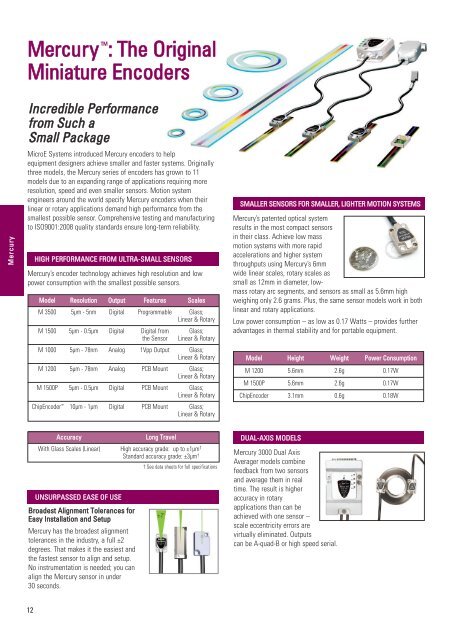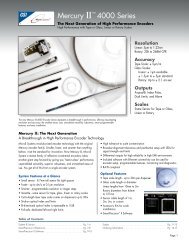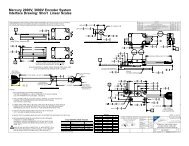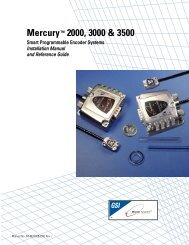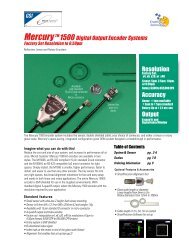MicroE Systems
MicroE-Systems-Product-Catalog.pdf
MicroE-Systems-Product-Catalog.pdf
You also want an ePaper? Increase the reach of your titles
YUMPU automatically turns print PDFs into web optimized ePapers that Google loves.
Mercury TM : The Original<br />
Miniature Encoders<br />
Mercury<br />
Incredible Performance<br />
from Such a<br />
Small Package<br />
<strong>MicroE</strong> <strong>Systems</strong> introduced Mercury encoders to help<br />
equipment designers achieve smaller and faster systems. Originally<br />
three models, the Mercury series of encoders has grown to 11<br />
models due to an expanding range of applications requiring more<br />
resolution, speed and even smaller sensors. Motion system<br />
engineers around the world specify Mercury encoders when their<br />
linear or rotary applications demand high performance from the<br />
smallest possible sensor. Comprehensive testing and manufacturing<br />
to ISO9001:2008 quality standards ensure long-term reliability.<br />
±2 o achieved with one sensor –<br />
SMALLER SENSORS FOR SMALLER, LIGHTER MOTION SYSTEMS<br />
Mercury’s patented optical system<br />
results in the most compact sensors<br />
in their class. Achieve low mass<br />
motion systems with more rapid<br />
HIGH PERFORMANCE FROM ULTRA-SMALL SENSORS<br />
Mercury’s encoder technology achieves high resolution and low<br />
power consumption with the smallest possible sensors.<br />
accelerations and higher system<br />
throughputs using Mercury’s 6mm<br />
wide linear scales, rotary scales as<br />
small as 12mm in diameter, lowmass<br />
rotary arc segments, and sensors as small as 5.6mm high<br />
Model Resolution Output Features Scales weighing only 2.6 grams. Plus, the same sensor models work in both<br />
M 3500 5µm - 5nm Digital Programmable Glass; linear and rotary applications.<br />
Linear & Rotary Low power consumption – as low as 0.17 Watts – provides further<br />
M 1500 5µm - 0.5µm Digital Digital from Glass; advantages in thermal stability and for portable equipment.<br />
the Sensor Linear & Rotary<br />
M 1000 5µm - 78nm Analog 1Vpp Output Glass;<br />
Linear & Rotary<br />
Model Height Weight Power Consumption<br />
M 1200 5µm - 78nm Analog PCB Mount Glass;<br />
Linear & Rotary<br />
M 1200 5.6mm 2.6g 0.17W<br />
M 1500P 5µm - 0.5µm Digital PCB Mount Glass;<br />
M 1500P 5.6mm 2.6g 0.17W<br />
Linear & Rotary ChipEncoder 3.1mm 0.6g 0.18W<br />
ChipEncoder 10µm - 1µm Digital PCB Mount Glass;<br />
Linear & Rotary<br />
Accuracy<br />
Long Travel<br />
DUAL-AXIS MODELS<br />
With Glass Scales (Linear) High accuracy grade: up to ±1µm †<br />
Standard accuracy grade: ±3µm †<br />
Mercury 3000 Dual Axis<br />
Averager models combine<br />
† See data sheets for full specifications<br />
feedback from two sensors<br />
and average them in real<br />
time. The result is higher<br />
UNSURPASSED EASE OF USE<br />
accuracy in rotary<br />
applications than can be<br />
scale eccentricity errors are<br />
virtually eliminated. Outputs<br />
can be A-quad-B or high speed serial.<br />
Broadest Alignment Tolerances for<br />
Easy Installation and Setup<br />
Mercury has the broadest alignment<br />
tolerances in the industry, a full ±2<br />
degrees. That makes it the easiest and<br />
the fastest sensor to align and setup.<br />
No instrumentation is needed; you can<br />
align the Mercury sensor in under<br />
30 seconds.<br />
12


